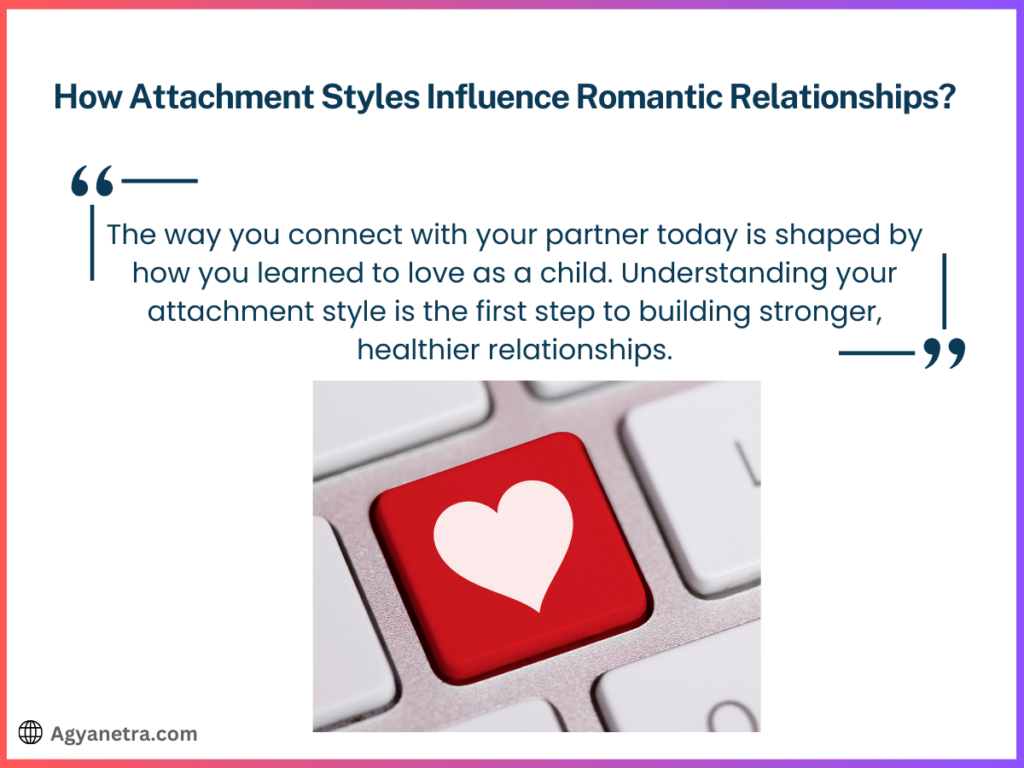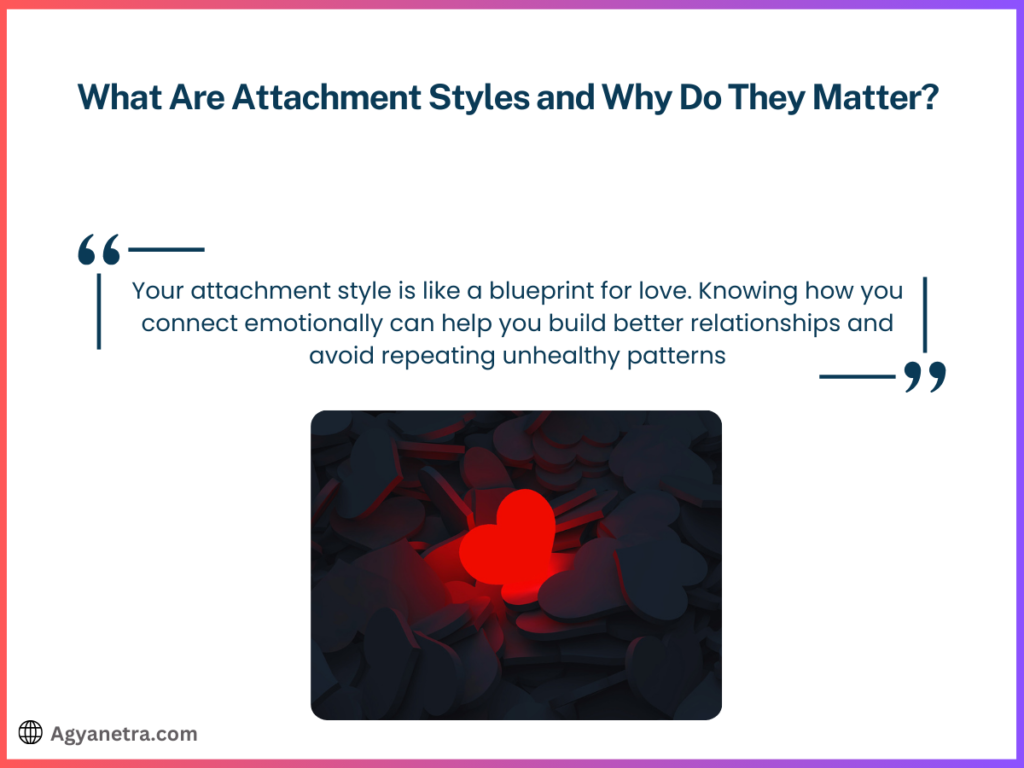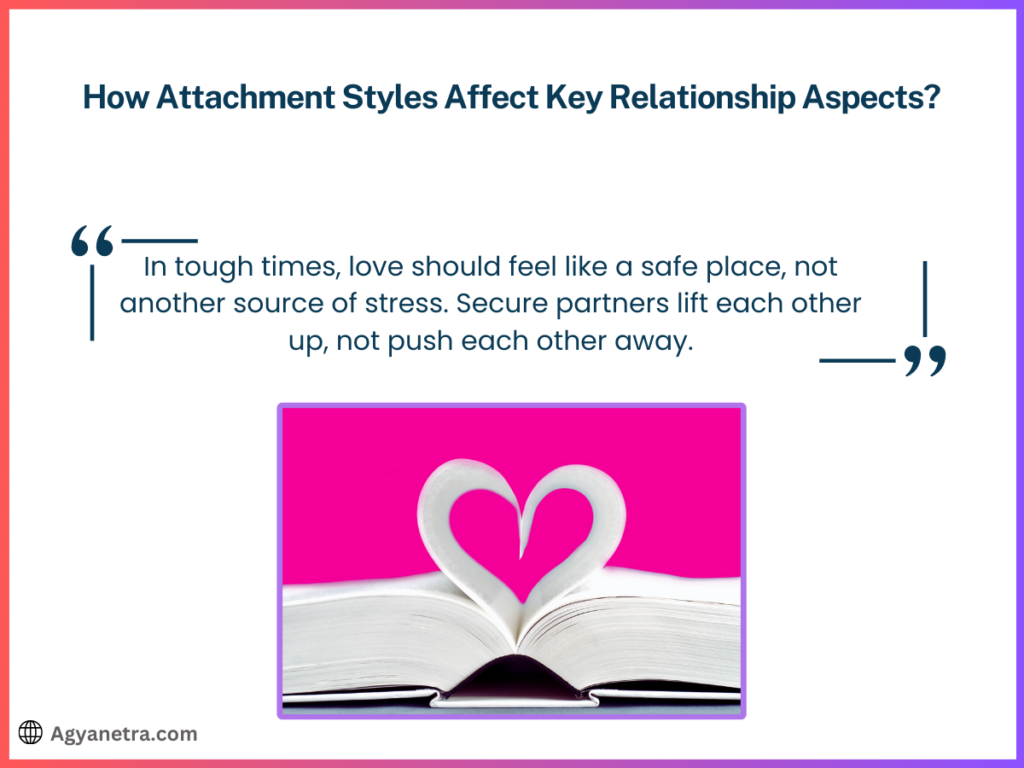How Attachment Styles Influence Romantic Relationships? Have you ever wondered why some relationships feel effortless while others are filled with anxiety, distance, or confusion?
The answer often lies in attachment styles—patterns of emotional bonding shaped in childhood that deeply affect how we connect with romantic partners.
Understanding your attachment style (and your partner’s) can unlock powerful insights into your relationships.
Whether you feel secure and trusting, constantly seek reassurance, avoid emotional closeness, or experience both craving and fear of intimacy, these patterns influence your love life in many ways.
Let’s dive in and uncover the key to creating stronger, more fulfilling relationships!
How Attachment Styles Influence Romantic Relationships: A Complete Guide
Have you ever wondered why some relationships feel easy and secure while others are filled with anxiety, fear, or emotional distance?

The answer often lies in attachment styles—patterns of emotional bonding formed in childhood that shape how we connect with romantic partners.
Understanding your attachment style (and your partner’s) can transform your relationships.
It helps explain why some people crave closeness while others push it away, why some communicate openly while others shut down, and why some relationships thrive while others struggle.
Today we’ll explore the four main attachment styles—secure, anxious-preoccupied, dismissive-avoidant, and fearful-avoidant—and how they impact love, trust, communication, and relationship success.
You’ll also discover practical ways to create stronger, healthier bonds, whether you’re dating, in a committed relationship, or simply seeking to understand yourself better.
More Posts Like This
- How Does Anxious Attachment Ruin Relationships
- Avoidant Attachment in Relationships
- How to Resolve Differences in a Relationship
- How to Build Strong Family Connections
What Are Attachment Styles and Why Do They Matter?
Attachment styles are patterns of emotional responses we develop early in life based on our interactions with caregivers.
These patterns continue into adulthood and shape how we relate to romantic partners.

If you’ve ever found yourself worrying about your partner’s feelings, avoiding emotional closeness, or struggling with trust, your attachment style might be influencing your relationships more than you realize.
Here’s a breakdown of the four main attachment styles and how they impact romantic relationships.
1. Secure Attachment: The Foundation of Healthy Relationships
People with a secure attachment style have a positive view of themselves and their partners.
They feel comfortable with intimacy and independence, making them more likely to build stable, trusting relationships.
How Secure Attachment Impacts Relationships:
- They are comfortable expressing emotions and discussing feelings.
- They trust their partners and believe in open communication.
- They handle conflicts constructively without fear of abandonment.
- They provide emotional support and expect the same in return.
Example: Sarah and Jake have a healthy, secure relationship. When Sarah is stressed about work, Jake listens, reassures her, and offers practical help. Instead of pushing him away or seeking excessive validation, Sarah appreciates his support and reciprocates when Jake needs comfort.
2. Anxious-Preoccupied Attachment: Seeking Constant Reassurance
People with an anxious-preoccupied attachment style crave closeness but often fear abandonment. They tend to overanalyze their partner’s words and actions, constantly seeking reassurance.
How Anxious Attachment Impacts Relationships:
- They worry about their partner’s feelings and need frequent validation.
- They experience emotional highs and lows based on their partner’s responses.
- They may become jealous or overly dependent on their partner.
- They struggle with insecurities and fear of rejection.
Example: Emily constantly texts her boyfriend, Mark, throughout the day. If he doesn’t respond quickly, she worries he’s losing interest. When he reassures her, she feels better—but the cycle repeats, causing tension in the relationship.
3. Dismissive-Avoidant Attachment: Prioritizing Independence Over Intimacy
People with a dismissive-avoidant attachment style value independence over emotional connection. They struggle with trust and may suppress their emotions, making it difficult for them to build deep relationships.
How Avoidant Attachment Impacts Relationships:
- They prefer emotional distance and avoid deep conversations.
- They struggle to rely on others or express vulnerability.
- They may push partners away during conflicts instead of resolving issues.
- They prioritize self-sufficiency over emotional intimacy.
Example: Alex enjoys spending time with his girlfriend but pulls away when she talks about feelings. When she expresses concern about their emotional connection, Alex brushes it off, making her feel unheard and disconnected.
4. Fearful-Avoidant Attachment: A Mix of Anxiety and Avoidance
This style combines both anxious and avoidant traits. People with fearful-avoidant attachment desire closeness but are afraid of getting hurt, leading to emotional push-and-pull behaviors.
How Fearful-Avoidant Attachment Impacts Relationships:
- They crave connection but fear getting too close.
- They experience inner conflict, leading to hot-and-cold behavior.
- They struggle with trust issues due to past emotional wounds.
- Their relationships tend to be unstable and confusing.
Example: Lisa wants a deep emotional connection but panics when things get too serious. When her boyfriend expresses love, she pulls away, fearing she’ll be hurt. When he distances himself, she feels abandoned and reaches out again.
How Attachment Styles Affect Key Relationship Aspects

Understanding your attachment style can help you recognize how you respond to stress, communicate, and handle conflicts in relationships.
1. Response to Stress
Secure partners comfort and support each other during difficult times. Insecure attachment styles can lead to emotional distress, making stress even harder to manage.
Example: When John loses his job, his secure partner helps him talk through his emotions and plan next steps. An anxious partner might worry they’ll be financially unstable, while an avoidant partner might withdraw completely.
2. Communication Patterns
Secure partners express their feelings openly. Anxious partners may seek constant reassurance, while avoidant partners shut down emotionally.
Example: A securely attached couple discusses their weekend plans calmly, while an anxious partner might stress over every detail, and an avoidant partner may ignore the conversation altogether.
3. Conflict Resolution
Secure partners work through conflicts together. Insecure attachment styles often lead to blame, withdrawal, or emotional outbursts.
Example: During an argument, a secure partner listens and tries to understand. An anxious partner might cry and beg for reassurance, while an avoidant partner might leave the room to avoid confrontation.
Can You Change Your Attachment Style?
Yes! While attachment styles are formed in childhood, they are not set in stone. With self-awareness, effort, and therapy, you can develop a more secure attachment style.
Practical Steps to Improve Your Attachment Style:
- Self-Reflection: Recognize your attachment patterns and how they impact your relationships.
- Therapy & Counseling: Working with a professional can help you heal past wounds.
- Mindfulness & Communication: Practice expressing emotions calmly and listening to your partner.
- Healthy Relationship Habits: Build trust, show appreciation, and work on emotional closeness.
Final Thoughts
Attachment styles play a powerful role in shaping love, trust, and emotional connection.
Whether you have a secure, anxious, avoidant, or fearful attachment style, understanding these patterns can help you build healthier, happier relationships.
By recognizing your attachment tendencies, working on effective communication, and making conscious efforts to improve emotional intimacy, you can create stronger, more fulfilling connections with your partner.
No relationship is perfect, but with awareness and effort, love can grow in a healthy and secure way—regardless of your starting point.
FAQs
What are attachment styles in relationships?
Attachment styles are emotional patterns that shape how people connect with romantic partners. Based on early childhood experiences, they influence trust, intimacy, and communication in relationships. The four main types are secure, anxious-preoccupied, dismissive-avoidant, and fearful-avoidant.
How does your attachment style affect romantic relationships?
Your attachment style determines how you handle intimacy, communication, and conflict. Secure attachment leads to healthy, trusting relationships, while insecure attachment (anxious, avoidant, or fearful) can cause emotional challenges like fear of abandonment or difficulty with closeness.
What is the healthiest attachment style for relationships?
A secure attachment style is the healthiest because it fosters trust, emotional security, and open communication. People with this style feel comfortable expressing emotions, resolving conflicts constructively, and supporting their partners.
Can you change your attachment style in relationships?
Yes! While attachment styles are shaped in childhood, they can evolve through self-awareness, therapy, and healthy relationship experiences. Practicing emotional regulation, improving communication, and forming secure connections can help shift towards a more secure attachment style.
How do I know my attachment style?
You can identify your attachment style by analyzing your relationship patterns, past experiences, and emotional responses. Many online attachment style quizzes can help, or you can consult a therapist for deeper insights.
What are the signs of an avoidant attachment style?
People with an avoidant attachment style prioritize independence over intimacy. They may:
Struggle with emotional closeness
Avoid deep conversations
Suppress emotions
Withdraw during conflicts
How do childhood experiences shape attachment styles?
Early interactions with caregivers shape attachment styles. Consistent and loving care fosters secure attachment, while neglect, unpredictability, or emotional unavailability can lead to insecure attachment styles.
How do attachment styles affect long-term relationship success?
Secure attachment leads to stable, fulfilling relationships, while insecure attachment may cause communication issues, emotional struggles, and fear of commitment. However, growth and emotional awareness can improve relationship dynamics.
Can attachment styles affect dating and choosing a partner?
Yes! People often unconsciously choose partners that match their attachment patterns. For example, an anxious person may be drawn to an avoidant partner, leading to emotional struggles. Understanding attachment styles can help in choosing compatible and healthy relationships.
Do attachment styles impact intimacy in relationships?
Yes, secure attachment fosters healthy emotional and physical intimacy, while insecure styles may cause fear of closeness, emotional withdrawal, or dependency. Understanding attachment styles can help partners create stronger emotional and physical connections.

Vidushi Gupta is an accomplished writer and digital marketing expert with contributions to organizations like Miles Educomp and ICAI. She has authored nearly ten novels and worked as a Senior Content Writer and Digital Marketing Specialist at ESS Global and Shabd. Her Quora posts have amassed almost 20 million views, reflecting her belief in the transformative power of the written word.

